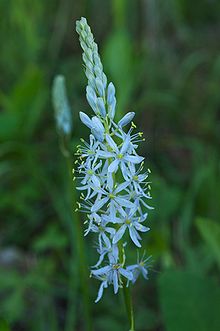Camassia scilloides
| Camassia scilloides | |
|---|---|

| |
| Scientific classification | |
| Kingdom: | Plantae |
| Clade: | Tracheophytes |
| Clade: | Angiosperms |
| Clade: | Monocots |
| Order: | Asparagales |
| Family: | Asparagaceae |
| Subfamily: | Agavoideae |
| Genus: | Camassia |
| Species: | C. scilloides
|
| Binomial name | |
| Camassia scilloides | |
| Synonyms[1] | |
|
Camassia esculenta | |
Camassia scilloides is a perennial herb known commonly as Atlantic camas, wild hyacinth,[2] and eastern camas.[3] It is native to the eastern half of North America, including Ontario and the eastern United States.[3]
It produces inflorescences up to half a meter tall from a bulb 1 to 3 centimeters wide. It has a few leaves each up to 60 centimeters long. The flowers have light blue or whitish tepals and yellow anthers. The green or brown capsule is up to a centimeter long.[3]
Native American groups used the bulbs for food, eating them raw, baked, roasted, boiled, or dried.[4]
Taxonomy
The superseded name Camassia esculenta (Ker Gawl.) B.L.Rob., (nom. illeg.)[5] should not be confused with Camassia esculenta (Nutt.) Lindl., a superseded name for Camassia quamash supsp. quamash.[6]
References
- ^ Rhodora 10: 31 (1908)
- ^ Camassia scilloides. NatureServe. 2012.
- ^ a b c Camassia scilloides. Flora of North America.
- ^ Camassia scilloides. Native American Ethnobotany. University of Michigan, Dearborn.
- ^ World Checklist of Selected Plant Families: Camassia esculenta (Ker Gawl.) B.L.Rob.
- ^ World Checklist of Selected Plant Families: Camassia esculenta (Nutt.) Lindl.
External links
 Media related to Camassia scilloides at Wikimedia Commons
Media related to Camassia scilloides at Wikimedia Commons- Camassia scilloides. USDA PLANTS
- Jalava, J. V. 2013. Recovery Strategy for the Wild Hyacinth (Camassia scilloides) in Ontario. Ontario Recovery Strategy Series. Ontario Ministry of Natural Resources, Peterborough.

